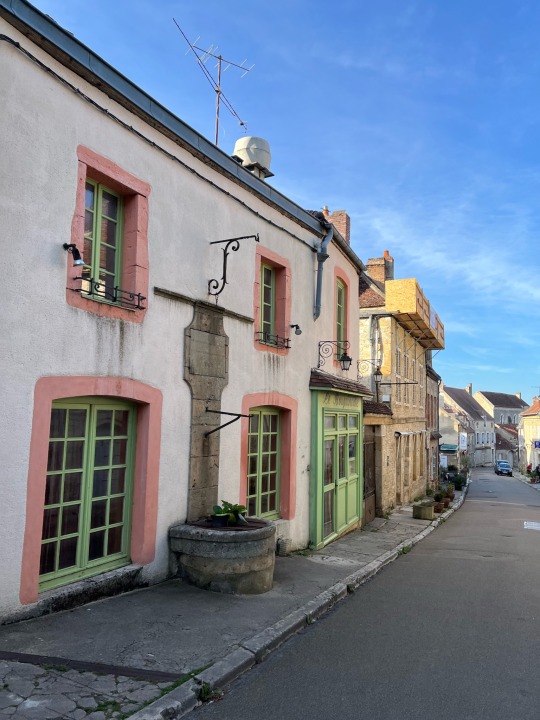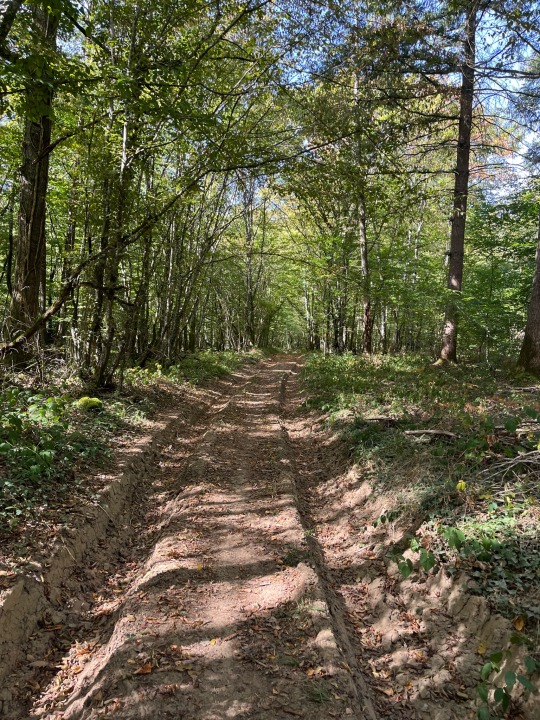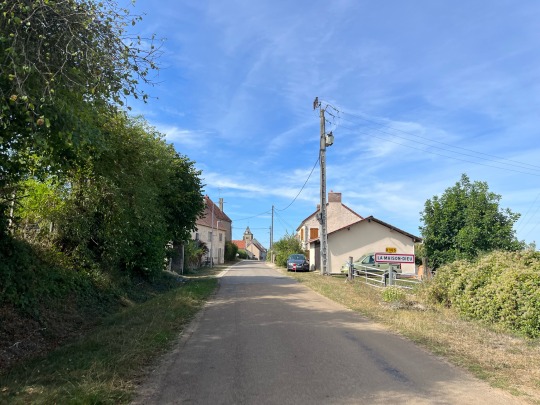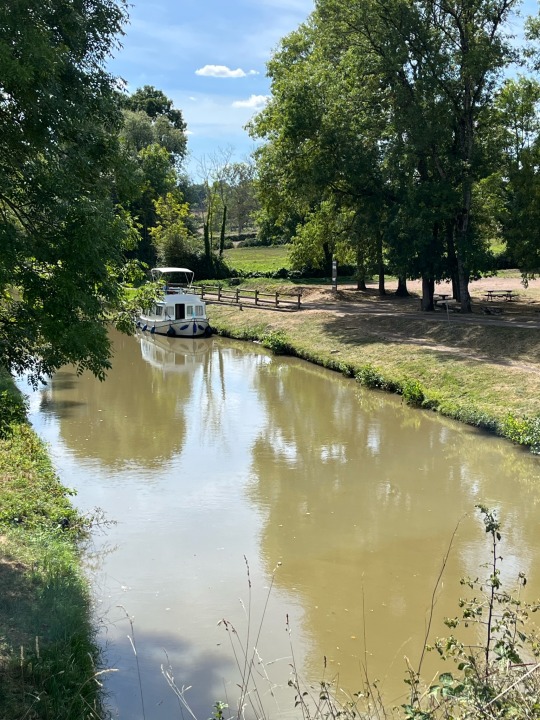#forêt domaniale
Explore tagged Tumblr posts
Text

"The Vichy regime incorporated the forest into its ‘back-to-the-land’ programme constructing the forest as a traditional, stable site in which to morally regenerate France. Jacques Chevalier, conservative philosopher and minister for public instruction between December 1940 and February 1941, considered that ‘life in the forest is the most healthy there is for the body and the soul, freeing us from the artifices of modern society’. He suggested that ‘eternal’ France resides in the forest. The forest constituted:
A living symbol of tradition, perpetuating history; old France is preserved better here than anywhere else; the present unites effortlessly with the past. In the silence and depth of the forest centuries replace one another, slowly, continuously, in the same way that the oak’s sapwood binds a new layer to those of springs and autumns past.
For Chevalier, trees represented a link between France’s past and present and acted as a guarantor of French traditions. Chevalier’s musings on trees and tradition are by no means uncharacteristic of the symbolic appropriation of trees. In the words of Douglas Davies, the tree is ‘a living entity, spanning many human generations. As such it avails itself as a historical marker and social focus of events’.
Forestry associations strove to incorporate the forest within the ‘National Revolution’. Just after the defeat, J. Jagerschmidt, the general secretary of the Comité des forêts argued that the forest was a ‘refuge of [the] old principles’ of Work, Family, Homeland. For Jagerschmidt, the forest epitomised the virtues of labour because ‘woodcutters and charcoal burners laughed at the paid holidays and forty hour week that the [Third Republic] wanted to impose on them’. Forest workers did not need to be told to work ‘from sunrise to sunset’. Family and forest also went together, according to Jagerschmidt, because the latter was a
symbol of tradition . . . of which the evolutionary rhythm exceeds several times the length of human life, [so] chimes perfectly well with the notion of the family, the linking of successive generations.
Furthermore, it was in the depths of the forest that the country’s ‘heart’ belonged. It is unclear whether such rhetoric represents deeply held beliefs or lip service to the newly installed regime. Either way, the forest’s politicisation is evident. The irony was, however, that such ‘back-to-the-land’ rhetoric simultaneously politicised the forest and constructed it as a space of ‘natural’ (and therefore apolitical) values and traditions
In a similar way to the peasant, the bûcheron (or woodcutter) was transformed into a patriotic figure labouring to regenerate France. Working in the forest helped strengthen male bodies and remake masculinity in post-defeat France. Two state foresters, Roger Blais and Gérard Luzu, published a guide to the ‘tough school’ of the forest, which presented forestry work as the most ‘radical’ return to the land and ‘an integral part of rural reconstruction’. They highlighted the ‘physical and moral enrichment’ the forester gleaned from the forest, ‘contributing to the affirmation of values and personal autonomy within the framework of nature’s laws and collective life’. In contrast to the ease of city living, life in the forest was ‘hard and healthy’ and woodcutting a ‘noble and free occupation’. Blais and Luzu also called for the forestry profession to conform to the principles of ‘social spirit and true hierarchy as outlined by the head of state’. Similarly, a 1943 article in Revue des Eaux et Forêts argued that ‘living in nature’ is the ‘best school’ and working in forestry teams countered individualism and selfishness because it cultivated the qualities of ‘sacrifice and charity’. These visions of forest life chimed with Vichy’s assumption that hard work was redemptive and served a national purpose.
Likewise, the forestry work of the Chantiers de la Jeunesse was supposed to contribute to male moral and physical regeneration. The Chantiers leadership viewed the forest as a safe and wholesome place, distant from the supposed immorality and decadence of modern society that reached its zenith in the city. From the outset, the Chantiers strove to remove its recruits from the ‘deleterious influence of the towns’ by making them camp out ‘in the great outdoors (en pleine nature), in the middle of the forest, hidden from all forms of trouble or agitation’.
The forest supposedly held important lessons for these young men, as it did for the rest of society. At Tronçais, Group One of the Chantiers dedicated a tree to their leader, Commissaire Furioux. In his speech during the ceremony, Forestry Inspector Desjeux pronounced that
it is through the living example of the forest, an example of tradition, continuity, and grandeur that [Furioux] wanted to impress on all those who had the honour of obeying [his] orders.
In a similar vein, Forestry Conservator Pascaud used his speech to identify the forest’s exemplary demonstration of ‘solidarity’. In particular, the oak tree towering serenely above surrounding trees protects them so that they grow to share the ‘light in which he bathes’. Addressing the Chantiers, Pascaud continued:
This solidarity of all plants, is it not the image of the best of societies where the leader must dominate in his pre-eminence while feeling himself surrounded, supported, [and] aided [by his followers]? If his entourage fails him, he succumbs, whatever his qualities. Let us remember this example at a moment when divisions lie in wait for us.
There was, however, some discrepancy between the regime’s rhetoric and the reality of forest life. The Chantiers’ leaders were well aware of the young men’s indifference, even outright hostility, to their new role as woodcutters. A 1943 report lamented that the Chantiers’ early enthusiasm and their ‘mentality of explorers out to discover new lands’ had since dissipated. Instead, the men no longer recognised the ‘usefulness of their work’ and the leadership itself admitted that ‘forestry work, interesting at first, quickly becomes monotonous, [and] tedious. Their hearts are not in the felling. Boredom is the dominant characteristic’. The joys of being a woodcutter were lost on those forced to work in the forests.
Nonetheless, the image of a stately oak leading and protecting his followers was a popular one. Yvonne Estienne’s illustrated children’s story La belle histoire d’un chêne (1943) compared France to a forest that had just been struck by a fierce storm. During the storm, trees swayed alarmingly in the wind and petrified birds and animals rushed to find shelter 'all the forest is unhappy. It looks for help’. Help came from the forest’s leader, a ‘tall, solid, upright tree’ who fears nothing and protects its charges. In case her young readers had missed the analogy, Estienne moved the story onto contemporary events: during the military defeat the French had fled from the enemy and its bombs ‘like the rabbits of the wood’. But luckily for France there was hope:
there existed, as well, in the forest of France – because men [sic] resemble trees – a tall, beautiful oak, already old but so valiant that he stood strong to protect everybody. And this tall, beautiful oak was called Marshal Pétain.
Helpfully, the Pétain oak tree carefully explained where the forest had gone wrong and how it should reform itself.
Vichy’s ideological appropriation of the forest reached its high point in Tronçais where an oak tree was named after Pétain on the initiative of Chevalier (his godson) and in the presence of forestry officials. Like the supposedly exceptional qualities of Pétain, the oak tree chosen to bear his name stood out from the rest: it stood 35 m high, was 260 years old and boasted good foliage. During the naming ceremony, Pétain unveiled a plaque bearing the words ‘Chêne Maréchal Pétain’ and made three marks on the tree with a Forestry Administration hammer. On one level, this event can be interpreted within the framework of the cult of personality created around Pétain, who admitted that he hoped that he would be able to ‘remain as upright as this tree in order to be able to devote [himself] to the service of the country’. The ceremony also implied that Pétain, like his oak tree, embodied the latest in a vulnerable line of strong, upright men devoted to France. As Chevalier asked during the ceremony; ‘who could doubt a country which produces such trees and such men?’
But beyond the construction of Pétain’s cult of personality, it is not too fanciful to see this marking of the tree as a performative device to reinforce the importance of the forest and the state’s claim to govern it. The occasion also served as a reminder of the forest’s historical role as ‘saviour’ of France. During the ceremony, Chevalier reminded his audience that this ancient forest provided wood for the Navy in 1793 and timber for the Army in 1917. Caziot, in a speech prepared for the ceremony, also emphasised the forest’s role as a productive space of ‘exceptional value for the material reconstruction of the country’. Now that France had crumbled under German invasion, forests would enable the nation to recover its former glory.
The ceremony suggested that Tronçais, which the state had replanted in the late seventeenth century, was physical evidence that France could rebuild itself under Vichy’s guidance. Caziot called for a contemporary display of determination equal to that of foresters who had replanted Tronçais:
The state of the Tronçais forest in 1670, was it not the image of France today, of the ravaged France, morally demolished by more than half a century of hideous demagogy? The war then added its own disasters. Today, everything must be remade, morally and materially. It is a fearsome task and one which demands long and patient effort as the rot runs deep. But the base has remained healthy and solid and allows for hope . . . On this solid base, which is the foundation of France, we can, in the image of Tronçais, remake a vigorous and healthy France. The oak which bears [Pétain’s] name must be a lesson and a symbol for everyone.
In this speech, Caziot compared the Third Republic with the damaged pre-1670 forest, but suggested that all was not lost because the forest’s essential nature (like France’s) had remained intact. There is also a sense that the forest’s and France’s ‘true’ essence lay beneath the surface of democracy and modernity, waiting to be recovered and restored. This speech was a manifestation of the right-wing idealisation of ‘True France’, which, as Herman Lebovics suggests, relied on a ‘discourse [that] employs the essentialist determinist language of a lost hidden authenticity that, once uncovered, yields a single, immutable national identity’.
Yet the forest’s political symbolism need not be reactionary. Vichy’s appropriation of the oak tree echoed previous state manipulation of this species. Ironically, given Vichy’s hostility to the French Republic, in the years following the French Revolution oaks were moulded into ‘Liberty Trees’. Like Vichy, revolutionary governments elevated the oak to the status of a ‘beacon tree’ controlling and sheltering surrounding trees. Moreover, French resistance units occupied the forest’s physical and symbolic space, transforming it into a site of resistance.
As the Occupation dragged on, resistance fighters identified the forest as a place to seek refuge and a base from which to oppose the Vichy regime and the German occupier. In places this development manifested itself symbolically. At Tronçais in February 1943, a resister reportedly scaled Pétain’s oak, replacing the plaque bearing the Marshall’s name with the following:
Chêne Gabriel Peri French Patriot Shot by the Nazis
Consequently, Pétain’s oak is now officially known as the ‘Oak of the Resistance’. But beyond this symbolic act, the resistance reclaimed the forest in more material ways." - Chris Pearson, Scarred Landscapes: War and Nature in Vichy France. New York: Palgrave MacMillan, 2008. p. 56-61.
#world war ii#occupied france#vichy france#régime de vichy#forêt de tronçais#l'allier#forêt domaniale#environmental history#histoire de france#research quote#reading 2024#national revolution#oak tree#reclaiming youth#forestry#revoluntion nationale#back to the land#chantiers de la jeunesse#marshal pétain
3 notes
·
View notes
Text

Forêt Domaniale de Guery (Auvergne) France
(iPhone) 2024
#photography#instagram#picoftheday#travel#photographie#rando#shotoniphone#landscapes#dreamplace#heart#nature#holydays#vacances#macro#macrophotography#happyplace#naturelover#auvergne#auvergne_landscape#auvergnetourisme#ontheroad
2 notes
·
View notes
Text
3 sept. 23, 14km, 31 degrés
Départ de Vezelay, variante Nord, direction Bourges. Balisage aux couleurs de l’Ukraine. Petite journée.
Les premiers 2/3 de notre marche du jour se sont marchés à l’ombre de la forêt domaniale Vézelienne. Première journée de marche, première débarque pour la marcheuse 🙄😃Pas de séquelles, juste « roulée » sur une branche.
En sortant de la forêt, nous passons par un minuscule village nommé La maison Dieu…ça ne peu que bien aller ☺️
Nous profitons loooonguememt des installations pèlerines. Table à pique-nique sous les arbres et brise agréable, toilettes et accès à l’eau potable.
Reste qu’environ 5 km de marche pour nous rendre à notre gîte.
S’amorce alors une lente et constante cuisson! Munis de nos chapeaux et serviettes au cou bien mouillées nous traversons les champs de tournesols et les billes de foin. Tout est chaud, sec…à un moment donné nous avons bénéficié de la fonction convection du four…une légère brise stimule la cuisson également 😅😅
La journée a été impeccable. Nous croisons un canal et ses péniches…Vivement une saucette!
Demain, nous reprenons le « braisage »…plus de 30 degrés pour la prochaine semaine.
Prenez un 5 minutes de clim à notre santé 😎😝










2 notes
·
View notes
Text

OBSERVER
11-2024 / Nouvelle mission avec l'Office National des Forêts et l'Agglo Seine Eure pour la construction d'un belvédère d'observation ouvert au public en Forêt domaniale de Bord-Louviers. Photographie Stéphane Ruchaud.
0 notes
Text

Hérault, Forêt domaniale de Sète, 26 mai 2023
Femelle de Rougequeue à front blanc
1 note
·
View note
Text
Pourquoi visiter le parc de Pierre Brune en famille ?
Quand on pense à des vacances en famille, on imagine souvent des plages ensoleillées ou des montagnes majestueuses. Mais avez-vous déjà pensé à un parc d’attractions niché au cœur de la nature ? Le parc de Pierre Brune, situé dans la magnifique forêt domaniale de Mervent, pourrait bien être la destination idéale pour une escapade inoubliable avec vos proches. Dans cet article, je vais vous…
0 notes
Text
Pourquoi visiter le parc de Pierre Brune en famille ?
Quand on pense à des vacances en famille, on imagine souvent des plages ensoleillées ou des montagnes majestueuses. Mais avez-vous déjà pensé à un parc d’attractions niché au cœur de la nature ? Le parc de Pierre Brune, situé dans la magnifique forêt domaniale de Mervent, pourrait bien être la destination idéale pour une escapade inoubliable avec vos proches. Dans cet article, je vais vous…
0 notes
Text
Pourquoi visiter le parc de Pierre Brune en famille ?
Quand on pense à des vacances en famille, on imagine souvent des plages ensoleillées ou des montagnes majestueuses. Mais avez-vous déjà pensé à un parc d’attractions niché au cœur de la nature ? Le parc de Pierre Brune, situé dans la magnifique forêt domaniale de Mervent, pourrait bien être la destination idéale pour une escapade inoubliable avec vos proches. Dans cet article, je vais vous…
0 notes
Text
Pourquoi visiter le parc de Pierre Brune en famille ?
Quand on pense à des vacances en famille, on imagine souvent des plages ensoleillées ou des montagnes majestueuses. Mais avez-vous déjà pensé à un parc d’attractions niché au cœur de la nature ? Le parc de Pierre Brune, situé dans la magnifique forêt domaniale de Mervent, pourrait bien être la destination idéale pour une escapade inoubliable avec vos proches. Dans cet article, je vais vous…
0 notes
Text
Great Escapes: Capricci
Temporary Link Forêt domaniale des Andaines – Normandie Have a Great Day 🙂 Please note that Art of the Day photos is now posted weekly on Fridays

View On WordPress
0 notes
Text
Bretagne : une nouvelle réserve biologique inaugurée dans les Côtes-d'Armor pour préserver la biodiversité
Le secrétaire d’État chargé de la Mer et de la Biodiversité Hervé Berville s’est rendu dans la forêt domaniale de Coat a
0 notes
Text
Diagonale royale en forêt de Marly
Randonnée de 20 km de gare à gare entre Poissy et Bougival Téléchargez la trace de cette randonnée au format . gpx ICI Cap à l’ouest de Paris, direction les forêts domaniales de St Germain-en-Laye et Marly . Le parcours de 20 km débute à la gare de Poissy (RER A) et se prolonge sud-est par une traversée intégrale de la forêt de Marly jusqu’à la gare de Bougival. Il est possible de l’écourter en…

View On WordPress
#forêt de St Germain en Laye#Foret de Marly#Gare de Bougival#gare de Poissy#rando 78#roman Richard Kirsch#Tribulations d&039;un boomer
0 notes
Text
Gironde : après les incendies en 2022, la forêt fait face à des insectes ravageurs
« Double peine » pour les forêts de Gironde incendiées en 2022: insectes ravageurs du bois, les scolytes ont proliféré cette année dans les pins affaiblis de La Teste-de-Buch, contraignant les forestiers à trancher dans le vif face à cette « bombe à retardement ».
Par AFP
Publié: 26 Octobre 2023 à 10h16
"Là où jadis s’élevaient des pins maritimes vieux de 250 ans, les machines vrombissent pour abattre, élaguer, tronçonner, stocker et évacuer les nombreux troncs infestés de parasites.
Le scolyte sténographe
Le long de la piste 214, qui traverse la forêt de La Teste, des milliers de rondins s’amoncellent, symboles d’une nouvelle urgence environnementale dans un département déjà ébranlé par les incendies monstres de l’été 2022, dans lesquels 30 000 hectares de forêt avaient brûlé.
C’est que le scolyte sténographe, petit insecte volant mesurant un demi-centimètre, s’attaque en priorité aux pins malmenés par un incendie ou une tempête. À l’accouplement, ce coléoptère marron s’infiltre entre l’écorce et le bois, pondant 30 à 50 larves qui vont creuser des galeries et détruire les canaux de sève, jusqu’à la mort de l’arbre.
« L’année 2023 est aussi cruelle et dramatique que l’incendie », regrette Matthieu Cabaussel, l’un des syndics généraux gérant l’ancestrale forêt usagère (privée) de La Teste-de-Buch. « C’est la double peine. »
Campagne d’abattage
Face aux scolytes, qui s’attaquent aussi aux épicéas dans l’est de la France et plus largement dans les forêts d’Europe de l’est, un choix s’impose: la coupe.
« Exploiter les bois attaqués, c’est le seul outil de lutte », explique Francis Maugard, responsable risques naturels pour l’Office national des forêts (ONF), en relevant un piège à phéromones utilisé pour mesurer la pullulation du coléoptère.
Tout près de la célèbre dune du Pilat, dans ce secteur littoral très fréquenté l’été, l’ONF a immédiatement lancé une campagne d’abattage dans la forêt domaniale (publique) de La Teste, dont la moitié des 2 030 hectares a brûlé. Quelque 80 000 m3 de bois ont été retirés, l’équivalent de vingt années de récolte.
Mais côté forêt usagère (FU), où la quasi-totalité des 3 800 hectares a été frappée par l’incendie, la réaction a tardé. Ses gestionnaires n’ont pu débuter les coupes qu’en janvier, après quelques tergiversations.
Une « gestion calamiteuse »
Une « gestion calamiteuse » pour Hervé Jactel, directeur de recherche du laboratoire BioGeCo (Biodiversité Gènes et Communautés) de l’Inrae qui critique aussi le stockage, à même la forêt, de piles de bois infestées.
« Ça a été le milieu de reproduction idéal », pointe-t-il, décrivant l’enchaînement de plusieurs générations de scolytes en 2023 sur fond de chaleur persistante. « Une vraie bombe à retardement: si l’on ne fait rien, le printemps 2024 va être plusieurs milliers de fois plus dangereux. »
Pour Matthieu Cabaussel, la malchance s’en est mêlée avec une météo chaude, ainsi qu’un marché « peu porteur » qui « freine la sortie du bois ».
« Pas en situation épidémique »
Le scolyte a déjà fait irruption dans les zones urbanisées de La Teste, contraignant des particuliers à abattre des pins dans leur jardin.
« Il y a un risque d’explosion des populations », confirme François Hervieu, de la Direction régionale de l’alimentation, l’agriculture et la forêt (DRAAF), tout en nuançant la menace : « On n’est pas en situation épidémique: on est dans une situation qui nécessite la plus grande vigilance pour évacuer les arbres en temps voulu. »
La nature, elle, reprend déjà ses droits: dans les sous-bois décimés, de jeunes pins en repousse pointent leurs épines parmi les souches calcinées et les fougères."
[Image] Le long de la piste 214, qui traverse la forêt de La Teste, des milliers de rondins s’amoncellent, symboles d’une nouvelle urgence environnementale. Photo PHILIPPE LOPEZ / AFP - AFP
0 notes
Text
Forêt domaniale de Clohars-Carnoet #Bretagne #Finistère





0 notes
Text

SAUVAGE
09-2024 / MWAH et PEAKS sont à mi-parcours dans la réalisation des folies en bois de la Forêt domaniale de Bord-Louviers. Inauguration le 25 octobre dans le cadre des Automnales du château de Martot. Photographie Stéphane Ruchaud.
0 notes


